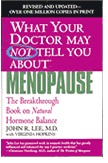
These are the kinds of letters, faxes and phone calls that doctors using natural hormones receive every day from women whose premenopausal symptoms clear up after they begin using a natural progesterone cream. It may sound too good to be true, but it's merely a case of supplying the body with what it needs to maintain balance. You've read about how out of balance our estrogenic environment has become; it's no wonder women are feeling much better when they use some progesterone.
MORE ABOUT NATURAL PROGESTERONEUnlike estrogen, progesterone is not a generic name but is the name of the hormone produced by the corpus luteum after ovulation, and in smaller quantities by the adrenal gland. It is synthesized in humans in a biochemical pathway leading from cholesterol to pregnenolone to progesterone. In turn, progesterone is the precursor of corticosteroids and testosterone. Progesterone is also synthesized, in copious amounts, by the placenta during pregnancy.
Progesterone is a specific molecule made by mammals and has multiple roles in your body. It effects every tissue in your body including the uterus, cervix, and vagina, the endocrine (hormonal) system, brain cells, fat metabolism, thyroid hormone function, water balance, peripheral nerve myelin sheath synthesis, bone cells, energy production and thermogenesis, the immune system, survival and development of the embryo, and growth and development of the fetus. Though referred to as a sex hormone, progesterone conveys no specific secondary sex characteristics and as such cannot be called a male or female hormone.
WHY PROGESTERONE CREAM WORKS SO EFFICIENTLYProgesterone is highly fat-soluble compound exceedingly well absorbed when applied transdermally or onto the skin. According to hormone researcher David Zava, Ph.D., progesterone is by far the most lipophilic, or fat-loving, of the steroid hormones. It circulates in the blood, carried by fat-soluble substances such as red blood cell membranes. Some 70 to 80 percent of ovary-made progesterone is carried on red blood cells and thus is not measured by serum or plasma blood tests. This progesterone is available to the body for use, and readily filters through the saliva glands into saliva where it can be measured accurately. The remaining 20 to 30 percent of progesterone in the body is protein-bound and is found in the watery blood plasma where it can be measured by serum or plasma blood tests. However, only 1 to 9 percent of this progesterone is available to the body for use. That is why saliva testing is a far more accurate and relevant test than blood tests in measuring bio-available progesterone.
WHY SO MANY WOMEN NEED PROGESTERONE AFTER MENOPAUSEThe fall of progesterone levels at menopause is proportionately much greater than the fall of estrogen levels. While estrogen falls only 40 to 60 percent from baseline on average, progesterone can decline to nearly zero. Furthermore, anovulatory cycles in premenopausal women will cause low progesterone levels on and off throughout the premenopausal years.
To read more about Natural Progesterone, please read Dr. Lee's books, What Your Doctor May Not Tell You About Menopause or What Your Doctor May Not Tell You About Premenopause.

|
What Your Doctor May Not Tell You About Menopause |